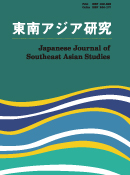All issues

Volume 21, Issue 4
Displaying 1-8 of 8 articles from this issue
- |<
- <
- 1
- >
- >|
Articles
-
Leonora E. Domingo, Kazutake Kyuma1984Volume 21Issue 4 Pages 361-373
Published: March 31, 1984
Released on J-STAGE: May 31, 2018
JOURNAL FREE ACCESSDownload PDF (689K) -
Denis Koh Soo Jin, Kyoko Tanaka1984Volume 21Issue 4 Pages 374-399
Published: March 31, 1984
Released on J-STAGE: May 31, 2018
JOURNAL FREE ACCESSDownload PDF (2054K)
Notes
-
Than Tun1984Volume 21Issue 4 Pages 400-408
Published: March 31, 1984
Released on J-STAGE: May 31, 2018
JOURNAL FREE ACCESSDownload PDF (651K) -
Hayao Fukui1984Volume 21Issue 4 Pages 409-436
Published: March 31, 1984
Released on J-STAGE: May 31, 2018
JOURNAL FREE ACCESSThis is a review paper on the present use and the future potential of swamp land in insular Southeast Asia. Though most swamp areas have been unutillzed or underutilized, they have some uses, traditional as well as recent. These include the starch extraction from sago palm in Irian Jaya and other islands, the pineapple cultivation on peats in Peninsular Malaysia, and the rice cultivation by tidal irrigation in Sumatra and Kalimantan. In this paper, the land conditions, technology employed, the economy of production, the population involved and their social background, and the limitations and potentials of future development of these uses are first described and discussed. Next, various experimental works on peat soil are reviewed, which include studies of both annual and perennial crops.
Based on these, several perspective views are presented. They are as follows:
(a) the equatorial swamp is so unique an ecosystem that efforts should be directed to devising similarly unique farming systems adapted to it rather than to bringing in systems evolved elsewhere by drastically modifying the land conditions;
(b) the deep peat swamps, of which the underlying mineral layer is so low that gravity drainage would eventually become impossible due to subsidence, should be left untouched given the present state of the art;
(c) lowland rice could be planted in some parts, but production of surplus rice in any significant amount seems unlikely due to the inherently low labor, if not land, productivity of swampy areas; and
(d) the low productivity per unit area of swamp land would not itself deter its use, and, therefore, such farming systems that might be low in terms of land productivity but high in terms of labor productivity should be sought.View full abstractDownload PDF (2801K) -
Hisao Furukawa1984Volume 21Issue 4 Pages 437-461
Published: March 31, 1984
Released on J-STAGE: May 31, 2018
JOURNAL FREE ACCESSThis review paper aims to describe the geographical features of coastal swamp lands in Insular Southeast Asia, mainly in the Indonesian Archipelago. The first of its three chapters is related to the recovery of the paleo-geography of the Sunda Sea. The eustatic submersion of the Sunda Land, which was proposed by Molengraaf and Weber, is considered to give the framework of the natural geography of the area. Modifying findings made more recently by radiocarbon dating and detailed boring studies are also reviewed.
The second chapter describes the ecological features of the two main environments which predominate the area, namely, mangrove and peat swamp. The peculiar practices of the rice cultivation therein are also described as indicators of the specificity of the environment.
The third chapter comprises case studies which, based on historical sources, try to indicate the growth and vicissitudes of the coastal lands in the historical period.View full abstractDownload PDF (2351K) -
3. Freshwater Swamp ForestIsamu Yamada1984Volume 21Issue 4 Pages 462-487
Published: March 31, 1984
Released on J-STAGE: May 31, 2018
JOURNAL FREE ACCESSFreshwater swamp forest occurs between mangrove/littoral forests and peat swamp/inland forests. This type is usually submerged permanently or temporarily by eutrophic fresh water. The vegetation change from mangrove to fresh-water swamp is gradual; the beginning of fresh-water swamp is marked by the appearance of the palm Oncosperma in most parts of the Malaysian region. The highest trees reach 50m, and many have peculiar root systems, such as buttress, prop, and aerial roots. Although this forest type has been the least surveyed in the tropics, many sites are disappearing with the present lowland development. Species composition, phenology, vegetation types and current development patterns of the freshwater swamp are reviewed.View full abstractDownload PDF (2123K)
Field Report etc.
-
Yoshihiro Kaida1984Volume 21Issue 4 Pages 488-489
Published: March 31, 1984
Released on J-STAGE: May 31, 2018
JOURNAL FREE ACCESSDownload PDF (279K) -
Article type: Bibliography
1984Volume 21Issue 4 Pages 490
Published: 1984
Released on J-STAGE: May 31, 2018
JOURNAL FREE ACCESSDownload PDF (85K)
- |<
- <
- 1
- >
- >|